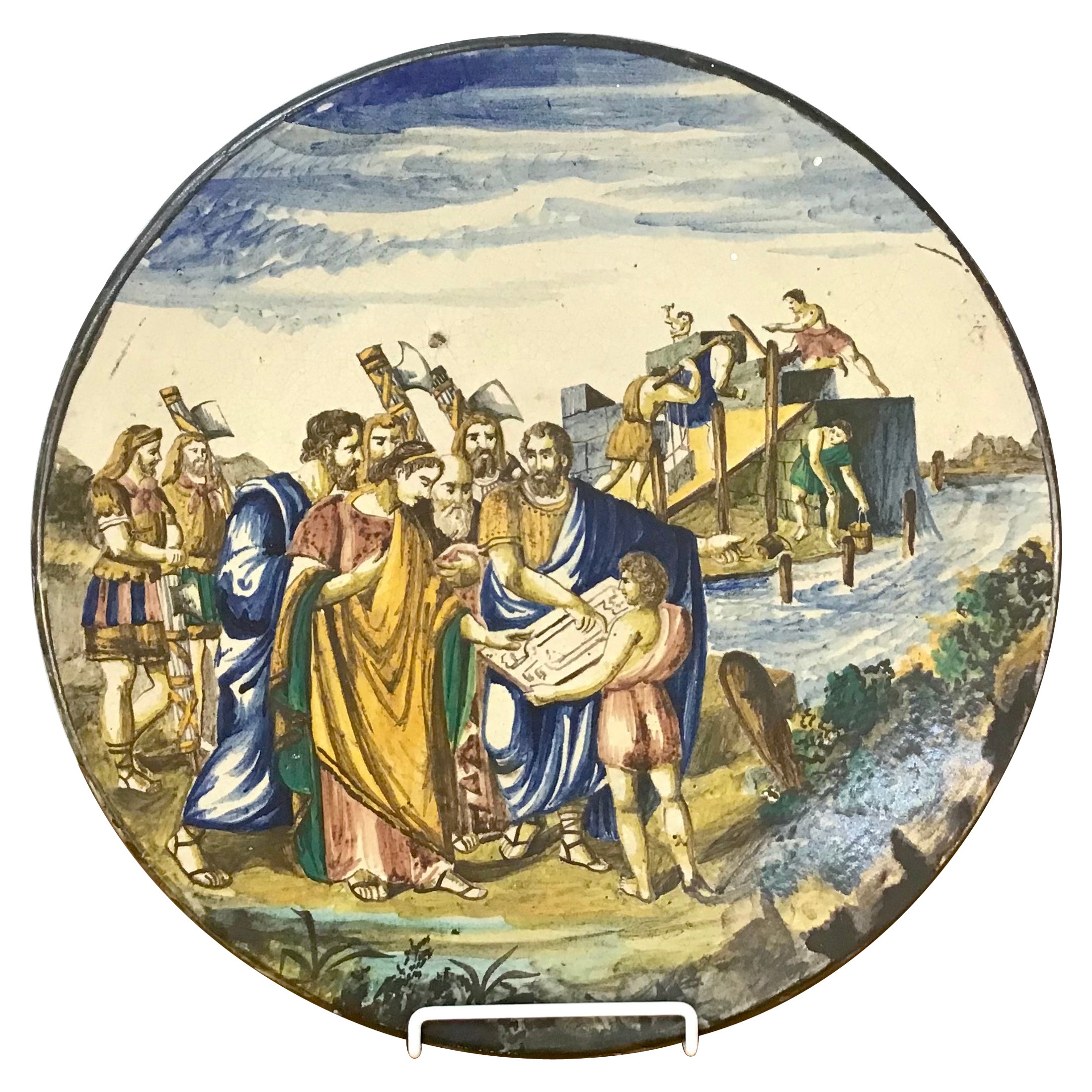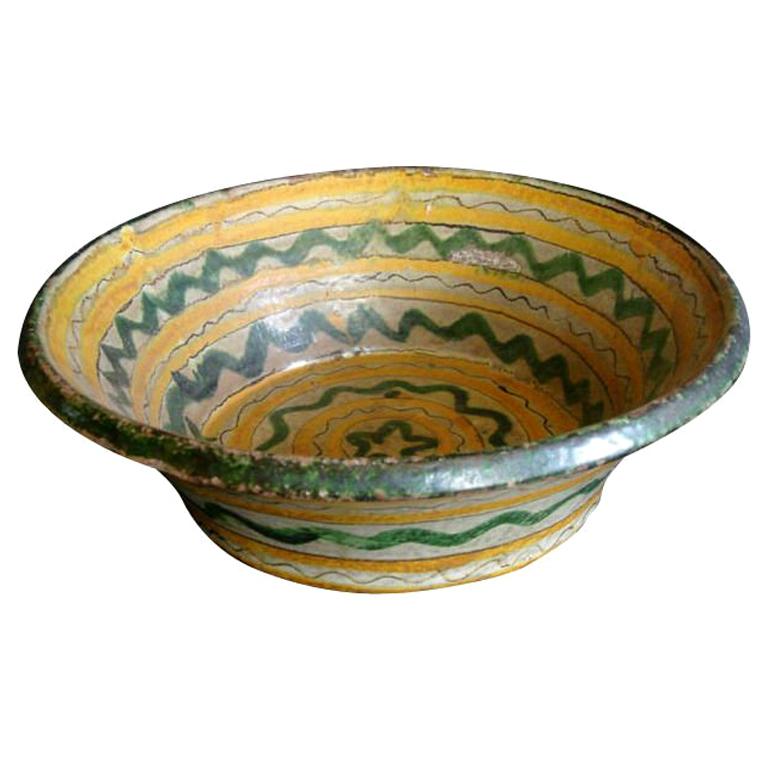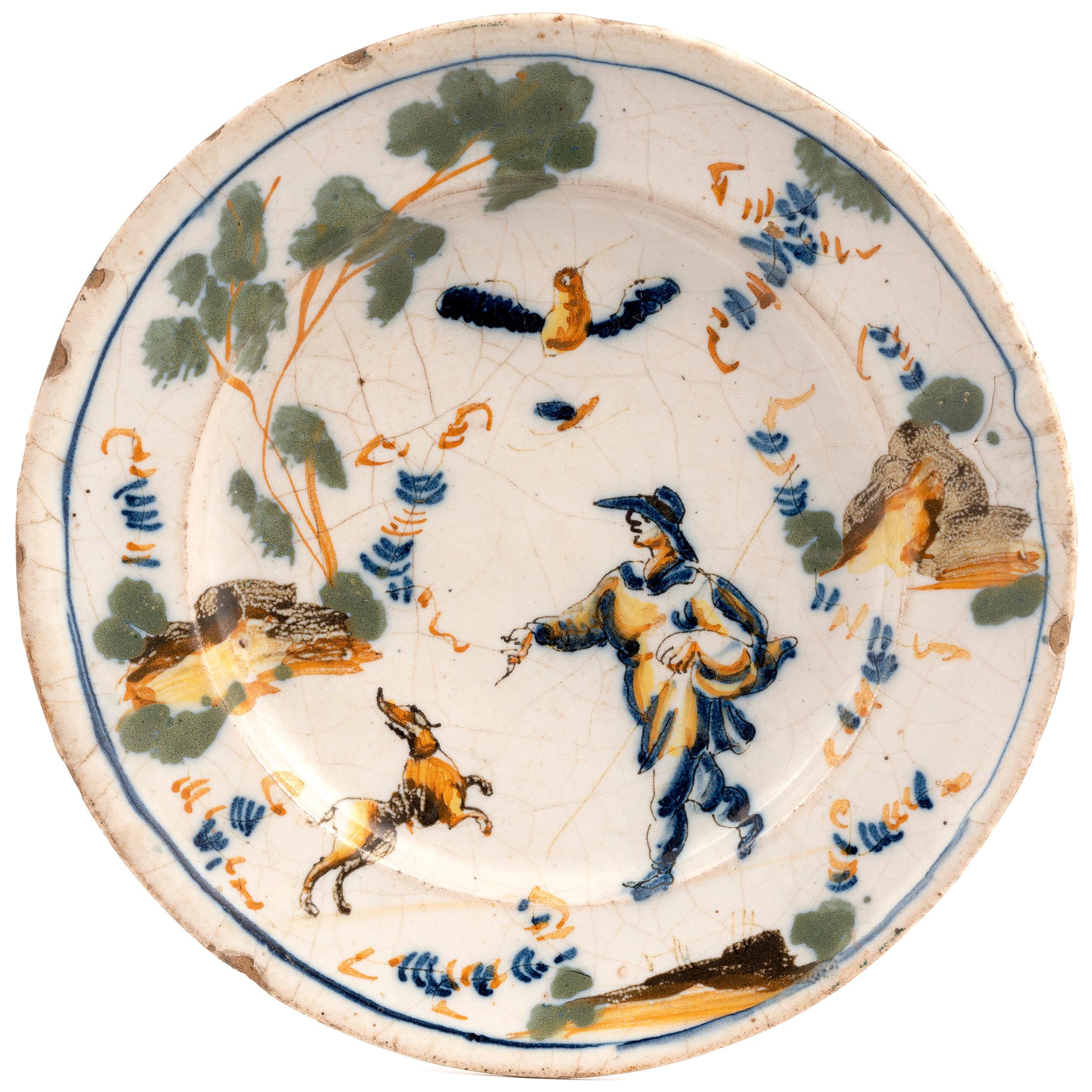Items Similar to 18th Century Italian Majolica Faience Centerpiece Large Lodi Circular Bowl
Want more images or videos?
Request additional images or videos from the seller
1 of 12
18th Century Italian Majolica Faience Centerpiece Large Lodi Circular Bowl
About the Item
18th century Italian collectible antique painted majolica bowl, a large basin-shaped centerpiece, with vertical ribs, decorated with polychrome flowers. Small chips, felure and minor losses as per images details. Wear consistent with age and use.
Unmarked, this maiolica bowl is of Italian origin, The type of decoration confirms Italian manufacture of Lodi, a city near Milan, in Lombardy region and dates back to mid-18th century.
This artwork is shipped from Italy. Under existing legislation, any artwork in Italy created over 70 years ago requires a governative license for export called Belle Arti. The shipping may require additional 3-4 handling weeks to require and get the license according to the final destination of the artwork.
- Dimensions:Height: 5.12 in (13 cm)Diameter: 11.82 in (30 cm)
- Style:Rococo (In the Style Of)
- Materials and Techniques:
- Place of Origin:
- Period:
- Date of Manufacture:1780
- Condition:Repaired: Some chips, felure and old restorations consistent with age and use. Wear consistent with age and use. Minor losses.
- Seller Location:Milan, IT
- Reference Number:
About the Seller
5.0
Vetted Seller
These experienced sellers undergo a comprehensive evaluation by our team of in-house experts.
Established in 1990
1stDibs seller since 2016
164 sales on 1stDibs
Typical response time: 3 hours
Associations
International Confederation of Art and Antique Dealers' Associations
- ShippingRetrieving quote...Ships From: Milan, Italy
- Return PolicyA return for this item may be initiated within 2 days of delivery.
More From This SellerView All
- 18th Century Italian Berrettino Majolica Faience RiserLocated in Milan, ITAn Italian maiolica berrettino-ground riser from 18th century, central Italy, probably Faenza origin. In the central part of the riser a ruined tower is painted within a mountain lan...Category
Antique Mid-18th Century Italian Rococo Decorative Dishes and Vide-Poche
MaterialsMaiolica
- Italian Faience 18th Century Majolica Riser with AnnunciationLocated in Milan, ITFrom Central Italy a 18th century Majolica Riser consisting of a flat circular dish with raised edge, resting on a base with a simple shape. The ...Category
Antique Mid-18th Century Italian Folk Art Vases
MaterialsMajolica
- 16th Century Italian Maiolica Faience Dish with a Young Man PortraitLocated in Milan, ITMid-16th Century Italian Maiolica Dish hand-painted in blue and ocher yellow color with a profile young man portrait in the center. The maiolica col...Category
Antique 16th Century Italian Renaissance Decorative Dishes and Vide-Poche
MaterialsMaiolica
- 18th Century Italian Majolica Albarello Drug Jar by Jacques BosellyBy Jacques Boselly 1Located in Milan, ITA Neoclassical late 18th century polychrome decorated drug jar or Albarello signed by the Italian Savonese artist Boselli Giacomo 1744-1808, a rare blue, yellow and polychrome majolica antique vase for collectors. The Italian Albarello...Category
Antique Late 18th Century European Neoclassical Vases
MaterialsMajolica
- Mid-19th Century Italian Tuscan Warmer BasketLocated in Milan, ITFrom Tuscany a ceramic basket realized with a circular vase with polychrome geometric decorations on the body and a relief decoration handmade by applied flowers and scrolls as well as on the handle. A Mid-19th Century Italian ceramic warmer, a circular basket...Category
Antique Mid-19th Century Italian Arts and Crafts Decorative Baskets
MaterialsCeramic, Terracotta
- Early 18th Century Italian Large Weight Scale 1715Located in Milan, ITStanding at nearly 51 inches in height, this large Italian scale from the 18th century features its original copper pans and crosspiece stamped by the I...Category
Antique Early 18th Century Italian Louis XV Scientific Instruments
MaterialsCopper, Iron
You May Also Like
- Large Italian Majolica Charger, circa 18th CenturyLocated in Bradenton, FLA large charger with a complex scene in polychrome glazes. Hand decorated glazed earthenware, 17.5" in diameter. This style of pottery decoration, originating about 1500 in Faenza, Italy, and popular throughout the 16th century, in which paintings comparable in seriousness to Italian Renaissance easel paintings were applied to majolica ware...Category
Antique Early 18th Century Italian Renaissance Decorative Dishes and Vid...
MaterialsPottery
- Late 17th-Early 18th Century Italian Majolica BowlLocated in Hudson, NYThis good sized bowl is a great example of the majolica wares produced in Italy throughout the 15th, 16th, 17, and 18th centuries. Humble and simple but highly decorative and enterta...Category
Antique Early 18th Century Italian Pottery
MaterialsMajolica
- 18th-19th Century Majolica Ceramic Baptismal BowlLocated in Los Angeles, CARare Large Antigua Majolica ceramic baptismal bowl in glazed terracotta.Category
Antique 19th Century Guatemalan Spanish Colonial Decorative Bowls
MaterialsTerracotta
- Italian Maiolica Ancient Sugar Bowl, Lodi, 1770-1780By Antonio FerrettiLocated in Milano, ITMaiolica sugar bowl Antonio Ferretti Manufacture Lodi, Circa 1770-1780 Maiolica polychrome decorated “a piccolo fuoco” (third fire). It measures 3.54 x 4.52 x 3.54 in (9 x 11,5 x 9 cm) Weight: 0.394 lb (0.179 kg) State of conservation: small and slight chips on the edges. The small sugar bowl has a swollen and ribbed body resting on a flat base. The cap-shaped lid follows the rib of the container and is topped with a small knob in the shape of a two-colored fruit. The sugar bowl is painted “a piccolo fuoco” (third fire) with the characteristic floral motif of bunches and isolated semis. An example which closely corresponds to this one is kept at the Civic Museum in Lodi (G. Gregorietti, Maioliche di Lodi, Milano e Pavia, Catalogo della Mostra, Milano, 1964 n. 137). This decorative style represented a strong point of the Lodi factory, which established itself thanks to the vivid nature of the colors made possible by the introduction of a new technique perfected by Paul Hannong in Strasbourg and later introduced by Antonio Ferretti to Italy. The production process, called “piccolo fuoco” (third fire), allowed the use of a greater number of colors than in the past; in particular, the purple of Cassius, a red made from gold chloride, was introduced. Its use allowed for many more tones and shades, from pink to purple. The Ferretti family started their maiolica manufacturing business in Lodi in 1725. The forefather Simpliciano started the business by purchasing an ancient furnace in 1725 and, indeed, we have evidence of the full activity of the furnaces starting from April of the same year (Novasconi-Ferrari-Corvi, 1964, p. 26 n. 4). Simpliciano started a production of excellence also thanks to the ownership of clay quarries in Stradella, not far from Pavia. The production was so successful that in 1726 a decree of the Turin Chamber came to prohibit the importation of foreign ceramics, especially from Lodi, to protect internal production (G. Lise, La ceramica a Lodi, Lodi 1981, p. 59). In its initial stages, the manufacture produced maolicas painted with the “a gran fuoco” (double fire) technique, often in turquoise monochrome, with ornamentation derived from compositional modules in vogue in Rouen in France. This was also thanks to the collaboration of painters like Giorgio Giacinto Rossetti, who placed his name on the best specimens next to the initials of the factory. In 1748 Simpliciano made his will (Gelmini, 1995, p. 30) appointing his son Giuseppe Antonio (known as Antonio) as universal heir. After 1750, when Simpliciano passed away, Antonio was directly involved in the maiolica factory, increasing its fortunes and achieving a reputation on a European level. Particularly important was the aforementioned introduction in 1760 of the innovative “a piccolo fuoco” (third fire) processing, which, expanding the ornamental repertoire with Saxon-inspired floral themes, was able to commercially compete with the German porcelains that had one of its most renowned offerings in the naturalistic Deutsche Blumen. Antonio Ferretti understood and promoted this technique and this decoration, proposing it in a fresher and more corrective version, less linked to botanical tables, both with or without contour lines, as well as in purple or green monochrome. After efforts to introduce more industrial production techniques to the sector succeeded, even the Ferretti manufacture, in the last decade of the eighteenth century, started heading towards decline despite its attempts to adapt production to neoclassical tastes. In 1796 the Napoleonic battle for the conquest of the Lodi bridge over the Adda definitively compromised the furnaces. Production resumed, albeit in a rather stunted manner, until Antonio's death on 29 December 1810. (M. L. Gelmini, pp. 28-30, 38, 43 sgg., 130-136 (for Simpliciano); pp. 31 sgg., 45-47, 142-192 (for Antonio). Bibliography G. Gregorietti, Maioliche di Lodi Milano e Pavia Catalogo della Mostra, Milano, 1964 n. 137; C. Baroni, Storia delle ceramiche nel Lodigiano, in Archivio storico per la città e i comuni del circondario e della diocesi di Lodi, XXXIV (1915), pp. 118, 124, 142; XXXV (1916), pp. 5-8; C. Baroni, La maiolica antica di Lodi, in Archivio storico lombardo, LVIII (1931), pp. 453-455; L. Ciboldi, La maiolica lodigiana, in Archivio storico lodigiano, LXXX (1953), pp. 25 sgg.; S. Levy, Maioliche settecentesche lombarde e venete, Milano 1962, pp. 17 sgg.; A. Novasconi - S. Ferrari - S. Corvi, La ceramica lodigiana, Lodi 1964, ad Indicem; Maioliche di Lodi, Milano e Pavia (catal.), Milano 1964, p. 17; O. Ferrari - G. Scavizzi, Maioliche italiane del Seicento e del Settecento, Milano 1965, pp. 26 sgg.; G. C. Sciolla, Lodi. Museo civico, Bologna 1977, pp. 69-85 passim; G. Lise, La ceramica a Lodi, Lodi 1981; M. Vitali, in Storia dell'arte ceramica...Category
Antique 1770s Italian Rococo Ceramics
MaterialsMaiolica
- Lodi Faience Plate, circa 1770Located in Firenze, ITSHIPPING POLICY: No additional costs will be added to this order. Shipping costs will be totally covered by the seller (customs duties included). Painted with a bird perched on flo...Category
Antique Late 18th Century Italian Neoclassical Decorative Bowls
MaterialsMaiolica
- 18th Century Spanish or North African Faience Deep BowlLocated in Chapel Hill, NCA stunning Spanish or North African faience deep bowl. 18th century. Well cared for with various old rim repairs typical of the form. Red ware base. 15 1/4" diameter, 4" height. We ...Category
Antique 18th Century Ceramics
MaterialsCeramic
Recently Viewed
View AllMore Ways To Browse
Italian Collectables
Circular Decorative Objects
Large Italian Bowl
Italian Majolica
Ships Bowl
Mid Century Majolica
Majolica Mid Century
Small Decorative Antique Italian
Hand Painted Small Bowl
Faience Italy
18th Century Bowl Hand
Circular Centerpiece
Antique Italian Majolica
Small Antique Baskets
Antique Bowls Small
Large Decorative Hand Painted Bowl
Flower Bowl Centerpiece
Antique Baskets Images





